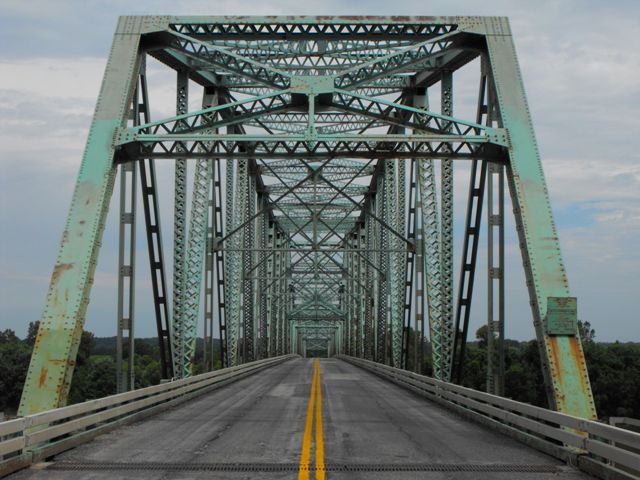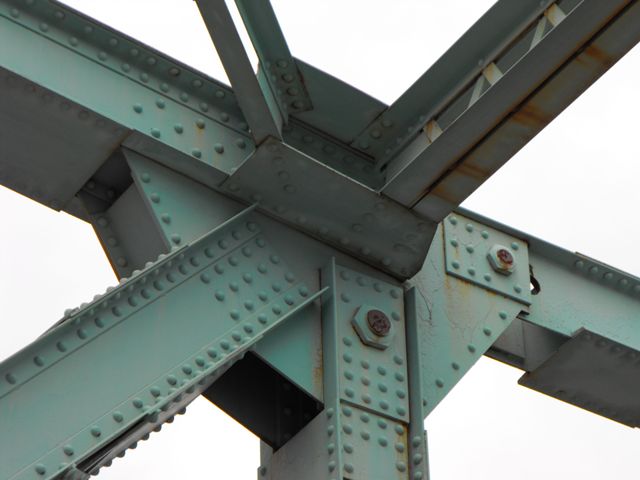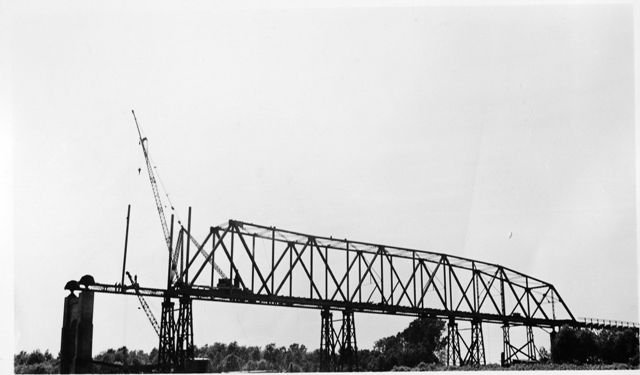We Recommend:
Bach Steel - Experts at historic truss bridge restoration.
BridgeHunter.com Phase 1 is released to the public! - Visit Now
Miami Bridge
McDaniel Memorial Bridge

Primary Photographer(s): Nathan Holth and Rick McOmber
Bridge Documented: July 2, 2009
Miami: Saline County, Missouri and Carroll County, Missouri: United States
Metal Cantilever 16 Panel Rivet-Connected Warren Through Truss, Fixed and Approach Spans: Metal 44 Panel Rivet-Connected Warren Deck Truss, Fixed
1939 By Builder/Contractor: Massman Construction Company of Kansas City, Missouri and Engineer/Design: Sverdrup and Parcel of St. Louis, Missouri
1983
475.0 Feet (144.8 Meters)
2,072.0 Feet (631.5 Meters)
23 Feet (7.01 Meters)
3 Main Span(s) and 11 Approach Span(s)
K09992

View Information About HSR Ratings
Bridge Documentation
This bridge no longer exists!
Vew Historic Bridge Recordation For This Bridge
View The Historic Bridge Inventory Data Sheets For This Historic Bridge
View The Historic Bridge Inspection File For This Historic Bridge
View A PDF Of The Original Superstructure Plans For This Historic Bridge (27.6mb)
This Historic Bridge Was Demolished October 27, 2009 at 8:05 AM CDT!
Miami Bridge: A Complete Documentation
HistoricBridges.org is proud to offer the original plans for the superstructure of this historic bridge, which Missouri Department of Transportation agreed to allow the display of following the closure of the historic bridge for demolition. It is hoped that these photos will help to complete the documentation of the historic bridge. These plans would allow for a replica or scale model of the bridge to be constructed, and they serve as a key to photographs and other historical narrations for the bridge, as well as documenting features of the bridge.
This bridge was an example of a large cantilever truss bridge. The bridge had a 16.5 Feet (5 Meters) vertical clearance, and in addition to its three main cantilever spans, 7 Steel Stringer, spans, and 4 Deck Truss, spans.
Missouri and Pennsylvania: Twin Sister States
This bridge has the honor of being the first Missouri Bridge on HistoricBridges.org. Missouri has one of the largest collection of historic truss bridges in the country, but this collection is rapidly shrinking as these bridges are being demolished rapidly. In this sense, Missouri with its MoDOT, is a state which is very similar to Pennsylvania with its PennDOT. Both are states with great potential: large quantities of beautiful, important historic bridges in beautiful settings. Both states are also shown to have one of the lowest percentage of historic bridge preservation success stories. Both states also have recently initiated a massive mass bridge replacement project as a simple, but costly (both in terms of history and money) way to reduce the percentage of structurally deficient bridges in the state. These programs might be more accurately described as Historic Bridge Demolition Programs, since most historic bridges in these states are not maintained and have structural deficiency, and as such these programs ravage historic bridge populations.
Miami Bridge: Significant!
The demolition of one of the most important (remaining) landmark Missouri bridges, the Miami Bridge, will begin as soon as MoDOT completes its similar nearby project whose goal was also to destroy a beautiful historic bridge, the Glasgow Bridge, despite possibilities for preservation for both bridges.
Why is the Miami Bridge important? For one, because MoDOT has demolished so many of its historic cantilever truss bridges that those which survive have become rare due to attrition. In addition, the Miami Bridge is a medium sized cantilever that retains excellent historic integrity. Cantilever truss bridges stand out as the largest and most complex of the various forms of historic truss bridges, and are especially significant for this reason. They also are rare nationally since only so many large bridges were built due to cost of large bridges and only so many crossings being large enough. The Miami Bridge is a significant crossing located on an important river. It has a great deal of aesthetic qualities as well. The bridge has the additional quality of being associated with Depression era relief programs. Like Depression glass in an antique store, Depression bridges are considered significant, as they are a physical artifact... a living history, of one of the most pivotal periods in United States history.
Rehabilitation: Feasible
The bridge could have been rehabilitated, and should have been, if for no other reason that for the historic value of the bridge. However it probably would not have been that expensive and difficult anyway. Often, estimated maintenance costs may be inflated a bit if for no other reason than for the protection of the engineers who make these assessments. The section loss present on the bridge had not gone too far to inhibit rehabilitation. MoDOT's comment that the 23 foot deck width is narrow for a bridge that carries under 2000 vehicles per day (1100 ADT in 2006, according to NBI) does not mean that demolition of the historic bridge was required, nor that a 23 foot wide deck is unacceptable and unsafe. The big secret out there is that AASHTO guidelines are guidelines, not U.S. Constitutional amendments. There are ways to make exceptions to the guidelines yet still maintain a safe and efficient crossing, as has been seen in preservation success stories in other states. Indeed, the Miami Bridge's width seemed acceptable for the traffic seen on the bridge during documentation which should have actually been worse than usual since the other area Missouri River crossing, Glasgow Bridge, was closed at the time. Further, MoDOT's claim that the historic bridge would cost more to maintain than a new bridge is also in question. The last major rehabilitation done on this bridge according to the National Bridge Inventory, was in 1983, which was 26 years ago. Over this 26 years it is not evident that significant funds of any kind were spent on this bridge. With that evidence, why is the public supposed to expect extensive funds spent over the next 25 years after a second rehab? Indeed, with either a brand new bridge or an old one, some money should be spent on maintenance of a bridge to prevent costly demolition and replacement. The Miami Bridge should have had more recent paint on all sections of truss located at and below the deck, paint newer than the rest of the bridge, because a greater amount of moisture attacks the bridge in this area and requires more frequent coats of paint. Bridges from Pittsburgh, Pennsylvania (West End Bridge) to bridges in Preble County, Ohio (Pyrmont Road Bridge) display this. In contrast, the Miami Bridge displayed paint holding up in fair condition except at and below the road level, where rust and section loss was evident. Surely if the bridge was rehabbed again in 2009, it could last another 25 years without maintenance. And surely it could last even longer than this with proper maintenance, and taking preventative measures to protect the lower portions of the truss.
Historic Value: A Legislator and Mayor A Day Late And A Dollar Short
Aside from MoDOT choosing to destroy this priceless historic artifact, the only thing more disturbing is the lack of people who spoke in favor of preserving the historic bridge when MoDOT held public meetings. Most comments received during these meetings did not express concern for the historic bridge and its preservation.
Worse, at the ceremonies for the beginning of the demolition/replacement project on October 5, 2009, State Rep. Joe Aull commented that the existing bridge was beautiful and mentioned a feeling of nostalgia in seeing it go. Miami mayor John Bakert described the existing bridge as looking like a "Normal Rockwell painting", and commented that he would miss the bridge and further commented on how they are disappearing. The big question is why on earth did none of these people speak up in favor of rehabilitation before it was too late?! Did they not know that the existing bridge could have been preserved and be rehabilitated into a safe and functional crossing for continued vehicular use?!
General Public: Misled or Uninformed
Although HistoricBridges.org did not attend the meetings during which the fate of the historic bridge was discussed/decided, one problem that frequently occurs at these sorts of public input meetings is that before people get to speak, the agency seeking demolition first displays photos of the historic bridge showing section loss at connections, and then talk about the importance of safety. They may fail to mention how feasible it is to correct section loss and how the bridge would be safe after such a rehab. The second problem is that due to a large range of causes and reasons, metal truss bridges like the Miami Bridge do not get portrayed to the general public as the important historic bridges they are. The general public only sees wooden covered bridges portrayed in travel brochures, DOT websites, classrooms, and the media. Why do wooden covered bridges on get preserved and recognized time and time again, while magnificent historic bridges like this receive little interest and attention from the general public? Because that is what the general public has been brainwashed with. Day after day the general public is bombarded with media that sensationalizes covered bridges, including art paintings, movies, travel brochures, magazine articles, area attractions road signs, and countless annual covered bridge tours. True, metal truss bridges often appear in movies and are frequent backdrops in automobile commercials, their placement is usually in the background. Doubtless, truss bridges are placed in such because of their superior aesthetic qualities over modern bridges, however the historic value of a bridge in a car commercial will not be explicitly pointed out, like a covered bridge is in a travel brochure or a covered bridge tour. It is unclear who is to blame, but it is wrong that historic bridges of other types, like metal truss bridges, are not recognized like wooden covered bridges. The Miami Bridge was a national eligible register bridge like these covered bridges, yet was there a sign posted for this bridge? What is clear is that the lack of public outcry against the demolition of this historic bridge probably had more to do with the public being uninformed than anything else. Any political scientist will tell you that a properly functioning democracy requires an informed citizenry. The consequences of an uninformed citizenry likely contributed to the lack of public comments favoring preservation.
Miami Bridge: Again, Significant
Because of the relatively few numbers of cantilever trusses compared to all other truss bridge types, rapid, widespread demolition plans for surviving cantilever truss bridges, and the historic and technological significance of a large, complex engineering structure like a cantilever truss bridges, HistoricBridges.org has no choice but to list such a structure with an HSR rating comparable to much older metal truss bridges such as a pin-connected Whipple truss, for example. A 8-8 HSR rating for this bridge is accurate and unbiased and reflects the value of the bridge and the current rarity and anticipated trend for this bridge type to continue to become rare. Indeed, this bridge may be under-rated when the fact that it is an extremely large example of a project funded by Depression relief programs is considered.

Information and Findings From Missouri's Historic Bridge InventoryBridge Features Upper chord, lower chord, and inclined end posts: 2 built-up channels with cover plate and double lacing; vertical: 2 channels with lacing, 4 angles with batten plates; diagonal: 2 channels with double lacing, 4 angles with batten plates; lateral bracing: 2 angles with lacing; strut: 4 angles with lacing and braces; floor beam: steel I-beam; guardrail: 2 channels; upper builder's plate text: Federal Emergency Administration of Public Works; Franklin D. Roosevelt, President of the United States; Harold L. Ickes, Administrator of Public Works; McDaniel Memorial Bridge; 1939; lower builder's plate text: McDaniel Memorial Bridge; built by Saline County Missouri with the cooperation of Missouri State Highway Commission; county court of Saline County, Robert L. Hyatt - presiding judge, T. M. Smith - judge, o. Boyd Davis - judge; Sverdrup and Parcel, consulting engineers; Massman Construction Co., general contractors; 1939 Discussion of Bridge Although Saline County had been promoting construction of a highway bridge over the Missouri River at Miami for some time, the process that led to the bridge's actual building began early in 1938, when the Saline County Court applied for Congressional approval for the bridge. The authorization was given on June 16, and the Federal Emergency Administration of Public Works immediately offered to pay 45 percent of the project's cost, up to $334,517.00. The county accepted the money and decided to sell toll revenue bridge bonds, totaling $460,000.00, to raise its portion of the necessary funds (the bonds would be retired through toll collected from the bridge itself). On July 5, 1938, the county accepted an offer from Stifel, Nicolaus and Company, Inc., of St. Louis, to purchase all of the revenue bonds, thus effectively financing the county's financial obligation. The Missouri State Highway Commission also agreed to contribute a sum of $125,000.00, to be used for payment of bonds and interest. The county hired St. Louis consulting engineers Sverdrup and Parcel to design the bridge. Sverdrup used a rigid-connected truss configuration similar to the one that the firm had employed on large-scale bridges at Nebraska City, Hannibal, Hermann and Gasconade, among others. As delineated by Sverdrup in 1938, the Miami Bridge consisted of three cantilevered through spans over the river's navigation channel, with a series of riveted deck truss and steel stringer approach spans, all supported by concrete piers and abutments. In early July, the county court approved Sverdrup's plans for the bridge and sent an application for approval to the Secretary of War in Washington, D.C. In mid-December 1938, Saline County then accepted a bid from the Massman Construction Company of Kansas City, Missouri, to construct the bridge for $493,788.00. Work began almost immediately on the substructural excavation; on June 27, 1940, the Miami Bridge was opened to traffic. Since that time the Waverly Bridge has functioned in place, with the replacement of its original concrete deck with the present open steel grid in 1983-84 as the only serious alteration to its historic fabric. Situated between the Waverly Bridge and the Glasgow Bridge, the Miami Bridge has not significantly altered traffic patterns in western Missouri. It has, however, functioned as a regionally important crossing of a major river for which crossings are relatively scarce. The Miami Bridge is perhaps more noteworthy as a superlative example of long-span truss construction. Employing rigid-connected Warren trusses that cantilever from the channel piers, the bridge is one of several such spans based on what Sverdrup and Parcel had developed as a trademark design. With its 475-foot main spans, the Miami Bridge fits well within the mainstream of great river highway bridge construction in Missouri. Bridge Considered Historic By Survey: Yes |
![]()
Photo Galleries and Videos: Miami Bridge
Structure Overview
Original / Full Size PhotosA collection of overview photos that show the bridge as a whole and general areas of the bridge. This gallery offers photos in the highest available resolution and file size in a touch-friendly popup viewer.
Alternatively, Browse Without Using Viewer
![]()
Structure Details
Original / Full Size PhotosA collection of detail photos that document the parts, construction, and condition of the bridge. This gallery offers photos in the highest available resolution and file size in a touch-friendly popup viewer.
Alternatively, Browse Without Using Viewer
![]()
Construction Photos
Original / Full Size PhotosA detailed and impressive collection of historical photos documenting the construction of this historic bridge. This gallery offers photos in the highest available resolution and file size in a touch-friendly popup viewer.
Alternatively, Browse Without Using Viewer
![]()
Structure Overview
Mobile Optimized PhotosA collection of overview photos that show the bridge as a whole and general areas of the bridge. This gallery features data-friendly, fast-loading photos in a touch-friendly popup viewer.
Alternatively, Browse Without Using Viewer
![]()
Structure Details
Mobile Optimized PhotosA collection of detail photos that document the parts, construction, and condition of the bridge. This gallery features data-friendly, fast-loading photos in a touch-friendly popup viewer.
Alternatively, Browse Without Using Viewer
![]()
Construction Photos
Mobile Optimized PhotosA detailed and impressive collection of historical photos documenting the construction of this historic bridge. This gallery features data-friendly, fast-loading photos in a touch-friendly popup viewer.
Alternatively, Browse Without Using Viewer
![]()
Suspended Span Demolition
Full Motion VideoIncludes comments from a resident sad to see bridge demolished. Video courtesy of MoDOT. Video showing demolition of the bridge. Streaming video of the bridge. Also includes a higher quality downloadable video for greater clarity or offline viewing.
![]()
North Cantilever Arm Demolition
Full Motion VideoIncludes comments from a resident sad to see bridge demolished. Video courtesy of MoDOT. Video showing demolition of the bridge. Streaming video of the bridge. Also includes a higher quality downloadable video for greater clarity or offline viewing.
![]()
South Cantilever Arm Demolition
Full Motion VideoIncludes comments from a resident sad to see bridge demolished. Video courtesy of MoDOT. Video showing demolition of the bridge. Streaming video of the bridge. Also includes a higher quality downloadable video for greater clarity or offline viewing.
![]()
Maps and Links: Miami Bridge
This historic bridge has been demolished. This map is shown for reference purposes only.
Coordinates (Latitude, Longitude):
Search For Additional Bridge Listings:
Bridgehunter.com: View listed bridges within 0.5 miles (0.8 kilometers) of this bridge.
Bridgehunter.com: View listed bridges within 10 miles (16 kilometers) of this bridge.
Additional Maps:
Google Streetview (If Available)
GeoHack (Additional Links and Coordinates)
Apple Maps (Via DuckDuckGo Search)
Apple Maps (Apple devices only)
Android: Open Location In Your Map or GPS App
Flickr Gallery (Find Nearby Photos)
Wikimedia Commons (Find Nearby Photos)
Directions Via Sygic For Android
Directions Via Sygic For iOS and Android Dolphin Browser
USGS National Map (United States Only)
Historical USGS Topo Maps (United States Only)
Historic Aerials (United States Only)
CalTopo Maps (United States Only)





